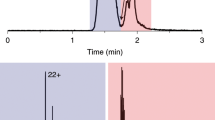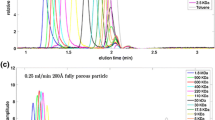Abstract
Triton X-100 has been widely used in many analytical and preparative protocols for a long time. Nevertheless, mass spectrometry, chromatographic separation, and spectrophotometric readout may be considerably hampered by this detergent due to signal suppression, complex formation, and high blank values, respectively. Additionally, Triton X-100 is not safe to remove prior to analytics. Here, microdialysis is introduced as a parallelizable, high-throughput method to clean samples from Triton X-100 with high efficacy and precision. To achieve this, we exploit the potential to considerably increase the critical micellar concentration of Triton X-100 by alteration of matrix properties. To that end, addition of several chaotropic compounds and organic solvents has been shown to increase the critical micellar concentration as well as the removal rate of the detergent. For application, matrix additives can be selected for analyte stability requirements out of a variety of compounds. Conveniently, all these additives are removable subsequently using the same microdialysis tool for downstream analytics requirements. Applicability and protocols are shown with proteomic sample preparation of purified proteins and complex protein mixtures prior to matrix-assisted laser desorption ionization (MALDI) mass spectrometry.







Similar content being viewed by others

Abbreviations
- BSA:
-
Bovine serum albumin
- CA:
-
Carbonic anhydrase
- CMC:
-
Critical micellar concentration
- CV:
-
Coefficient of variation
- DLS:
-
Dynamic light scattering
- DMSO:
-
Dimethylsulfoxide
- DTT:
-
Dithiothreitol
- GHC:
-
Guanidine hydrochloride
- H33342:
-
Hoechst dye bisbenzimide trihydrochloride
- HCl:
-
Hydrochloride
- LOQ:
-
Limit of quantification
- MALDI-TOF:
-
Matrix-assisted laser desorption ionization–time of flight
- MD100:
-
Xpress Micro Dialyzer (for volumes of up to 100 μl of sample)
- MWCO:
-
Molecular weight cutoff
- NaI:
-
Sodium iodide
- NaSCN:
-
Sodium thiocyanate
- NH4HCO3 :
-
Ammonium bicarbonate
- SD:
-
Standard deviation
- TB:
-
Tris buffer (containing 100 mM Tris/HCl, pH 7.4)
- TEB:
-
Triethanolamine buffer (containing 100 mM triethanolamine hydrochloride/HCl and 0.02 % (w/v) sodium azide, pH 7.4)
- TFA:
-
Trifluoroacetic acid
- Tris:
-
Tris(hydroxymethyl)aminomethane
- TX:
-
Triton X-100
- α-CD:
-
α-Cyclodextrin
References
Lin SH, Guidotti G (2009) Purification of membrane proteins. Methods Enzymol 463:619–629. doi:10.1016/S0076-6879(09)63035-4
Weiss W, Gorg A (2008) Sample solublization buffers for two-dimensional electrophoresis. Methods Mol Biol 424:35–42. doi:10.1007/978-1-60327-064-9_3
Neugebauer JM (1990) Detergents: an overview. Methods Enzymol 182:239–253
Vuckovic D, Dagley LF, Purcell AW, Emili A (2013) Membrane proteomics by high performance liquid chromatography-tandem mass spectrometry: analytical approaches and challenges. Proteomics 13(3–4):404–423. doi:10.1002/pmic.201200340
Sharma R, Dill BD, Chourey K, Shah M, VerBerkmoes NC, Hettich RL (2012) Coupling a detergent lysis/cleanup methodology with intact protein fractionation for enhanced proteome characterization. J Proteome Res 11(12):6008–6018. doi:10.1021/pr300709k
Canas B, Pineiro C, Calvo E, Lopez-Ferrer D, Gallardo JM (2007) Trends in sample preparation for classical and second generation proteomics. J Chromatogr A 1153(1–2):235–258. doi:10.1016/j.chroma.2007.01.045
Funk J, Li XP, Franz T (2005) Threshold values for detergents in protein and peptide samples for mass spectrometry. Rapid Commun Mass Spectrom 19(20):2986–2988. doi:10.1002/rcm.2142
Lin Y, Huo L, Liu Z, Li J, Liu Y, He Q, Wang X, Liang S (2013) Sodium laurate, a novel protease- and mass spectrometry-compatible detergent for mass spectrometry-based membrane proteomics. PLoS One 8(3):e59779. doi:10.1371/journal.pone.0059779
Ning Z, Seebun D, Hawley B, Chiang CK, Figeys D (2013) From cells to peptides: “one-stop” integrated proteomic processing using amphipols. J Proteome Res 12(3):1512–1519. doi:10.1021/pr301064z
Hjelmeland LM (1990) Removal of detergents from membrane proteins. Methods Enzymol 182:277–282
Antharavally BS, Mallia KA, Rosenblatt MM, Salunkhe AM, Rogers JC, Haney P, Haghdoost N (2011) Efficient removal of detergents from proteins and peptides in a spin column format. Anal Biochem 416(1):39–44. doi:10.1016/j.ab.2011.05.013
Yeung YG, Nieves E, Angeletti RH, Stanley ER (2008) Removal of detergents from protein digests for mass spectrometry analysis. Anal Biochem 382(2):135–137. doi:10.1016/j.ab.2008.07.034
Suzuki Y, Kabayama K (2012) Convenient and rapid removal of detergent from glycolipids in detergent-resistant membrane microdomains. J Lipid Res 53(3):599–608. doi:10.1194/jlr.D020545
Hengel SM, Floyd E, Baker ES, Zhao R, Wu S, Pasa-Tolic L (2012) Evaluation of SDS depletion using an affinity spin column and IMS-MS detection. Proteomics 12(21):3138–3142. doi:10.1002/pmic.201200168
Gehrhardt S, Blume E, Cumme GA, Bublitz R, Rhode H, Horn A (2000) Gel chromatographic characterization of the hydrophobic interaction of glycosylphosphatidylinositol-alkaline phosphatase with detergents. Biol Chem 381(2):161–172. doi:10.1515/bc.2000.022
Rowe B, Schmidt JJ, Smith LA, Ahmed SA (2010) Rapid product analysis and increased sensitivity for quantitative determinations of botulinum neurotoxin proteolytic activity. Anal Biochem 396(2):188–193. doi:10.1016/j.ab.2009.09.034
Rodriguez-Cruz MS, Sanchez-Martin MJ, Sanchez-Camazano M (2004) Enhanced desorption of herbicides sorbed on soils by addition of Triton X-100. J Environ Qual 33(3):920–929
Samluk L, Czeredys M, Nalecz KA (2010) Regulation of amino acid/carnitine transporter B 0,+ (ATB 0,+) in astrocytes by protein kinase C: independent effects on raft and non-raft transporter subpopulations. J Neurochem 115(6):1386–1397. doi:10.1111/j.1471-4159.2010.07040.x
Midura RJ, Yanagishita M (1995) Chaotropic solvents increase the critical micellar concentrations of detergents. Anal Biochem 228(2):318–322. doi:10.1006/abio.1995.1357
Mukherjee P, Padhan SK, Dash S, Patel S, Mishra BK (2011) Clouding behaviour in surfactant systems. Adv Colloid Interf 162(1–2):59–79. doi:10.1016/j.cis.2010.12.005
Maischak H, Tautkus B, Kreusch S, Rhode H (2012) Proteomic sample preparation by microdialysis: easy, speedy, and nonselective. Anal Biochem 424(2):184–186. doi:10.1016/j.ab.2012.01.037
Hoffmann-Blume E, Marenco MBG, Ehle H, Bublitz R, Schulze M (1991) Evidence for glycosylphosphatidylinositol anchoring of intralumenal alkaline phosphatase of the calf intestine. FEBS J 199(2):305–312. doi:10.1111/j.1432-1033.1991.tb16125.x
Jumpertz T, Tschapek B, Infed N, Smits SH, Ernst R, Schmitt L (2011) High-throughput evaluation of the critical micelle concentration of detergents. Anal Biochem 408(1):64–70. doi:10.1016/j.ab.2010.09.011
Wendler S, Tautkus B, Nemitz S, Pesek JTK, Opitz S, Bartz M, Richter S, Oehme H, Haenel T, Moore T, Kreusch S, Hanf B, Schmidt L, Rhode H (2013) Automated native sample preparation for proteome analysis. In: Arent D, Freebush M (eds) Automation systems of the 21st century: new technologies, applications and impacts on the environment & industrial processes. Nova, New York, pp 1–50
Yeung Y, ER S (2010) Rapid detergent removal from peptide samples with ethyl acetate for mass spectrometry analysis. In: Current protocols in protein science. pp. 1612–1659
Anand U, Jash C, Mukherjee S (2011) Spectroscopic determination of critical micelle concentration in aqueous and non-aqueous media using a non-invasive method. J Colloid Interface Sci 364(2):400–406. doi:10.1016/j.jcis.2011.08.047
Sun L, Hao D, Zhang P, Qian Z, Shen W (2013) Indication of critical micelle concentration of nonionic surfactants with large emission change using water-soluble conjugated polymer as molecular light switch. J Lumin 134:260–265. doi:10.1016/j.jlumin.2012.08.035
Alauddin M, Parvin T, Begum T (2009) Effect of organic additives on the cloud point of Triton X-100 micelles. J Appl Sci 9(12):2301–2306
Attwood D, Terreros A, Lopez-Cabarcos E, Galera-Gomez PA (2000) Light scattering study of the effect of n-butanol on the micellar properties of undecylammonium chloride in aqueous electrolyte solutions. J Colloid Interface Sci 225(1):25–31. doi:10.1006/jcis.2000.6716
Gu TR, Galera-Gomez PA (1999) The effect of different alcohols and other polar organic additives on the cloud point of Triton X-100 in water. Colloids Surf A Physicochem Eng Asp 147(3):365–370. doi:10.1016/s0927-7757(98)00710-9
Mahajan RK, Vohra KK, Kaur N, Aswal VK (2008) Organic additives and electrolytes as cloud point modifiers in octylphenol ethoxylate solutions. J Surfactant Deterg 11(3):243–250. doi:10.1007/s11743-008-1074-6
Soni SS, Panjabi SH, Sastry NV (2011) Effect of non-electrolyte additives on micellization and clouding behavior of silicone surfactant in aqueous solutions. Colloids Surf A Physicochem Eng Asp 377(1–3):205–211. doi:10.1016/j.colsurfa.2010.12.048
van Bommel A, Palepu RM (2004) n-Alkanol induced clouding of Brij® 56 and the energetics of the process. Colloids Surf A Physicochem Eng Asp 233(1–3):109–115. doi:10.1016/j.colsurfa.2003.11.013
Abrahmsen-Alami S, Alami E, Eastoe J, Cosgrove T (2002) Interaction between a novel gemini surfactant and cyclodextrin: NMR and surface tension studies. J Colloid Interface Sci 246(1):191–202. doi:10.1006/jcis.2001.8058
Topchieva I, Karezin K (1999) Self-assembled supramolecular micellar structures based on non-ionic surfactants and cyclodextrins. J Colloid Interface Sci 213(1):29–35. doi:10.1006/jcis.1998.6065
Rhode H, Endmann H, Kreusch S, Händel M, Sammler G, Zimmermann E (2008) Device for receiving, treating, and storing small volume samples. Patent application: WO002008106960A1, PCT/DE2008000412, DE102007011866A1
Acknowledgments
We thank Dr. Holger Wondraczek and Thomas Elschner (Institute for Organic Chemistry and Macromolecular Chemistry, Friedrich Schiller University Jena) for giving us the opportunity to measure on Zetasizer Nano ZS and their kind help, Sindy Wendler and Dr. Rita Büchler (Institute of Biochemistry I) for their technical support, and Dr. Rolf Nitzsche (Malvern Instruments) for discussing our results from DLS measurements. For language editing, Laura McMillan (Institute of Biochemistry I) is gratefully acknowledged. The financial support of the Federal Ministry for Economic Affairs and Energy and the Central Innovation Program SME (KF 2937601FR1) and of the DFG Collaborative Research Center/Transregio 124 – FungiNet (project Z2) is gratefully acknowledged.
Author information
Authors and Affiliations
Corresponding author
Electronic supplementary material
Below is the link to the electronic supplementary material.
ESM 1
(PDF 378 kb)
Rights and permissions
About this article
Cite this article
Opitz, S., Hannika, F., Krüger, T. et al. The removal of Triton X-100 by dialysis is feasible!. Anal Bioanal Chem 407, 1107–1118 (2015). https://doi.org/10.1007/s00216-014-8333-3
Received:
Revised:
Accepted:
Published:
Issue Date:
DOI: https://doi.org/10.1007/s00216-014-8333-3



